Water, Worms and Measuring
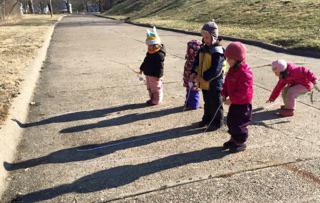
posted by Diann Gano
Have you ever seen a child with a tape measure? They are in all their glory! We have small tape measures that sometimes make it on our walks around the neighborhood. We like to measure seedpods, sticks, each other, our shadows, you name it. Did you find a worm? We are measuring machines. We like tape measures that are small enough to fit in a pocket, because you just never know when you will need to measure something. We may not know the numbers or what the spaces means, but it is fun! It exposes them to the concept and the visual number, when their brain is ready the important parts will fall into place.
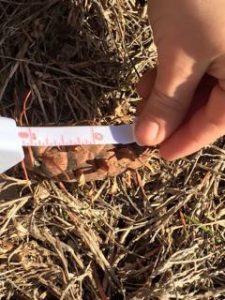
Living on the Mississippi River, each spring we get sucked into watching our beloved bald eagles. When we decided we should make our own nest, out came the tape measures! Did you know the average eagle nest is six feet wide? This is the perfect time to grab a tape measure and create a nest!
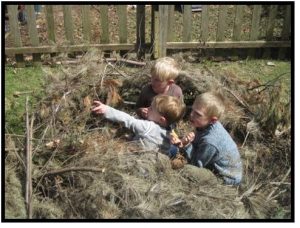
We use worms to teach length and we sometimes measure them with tape measures but we honestly do a lot more observation and estimating with them because they are perfect just the way they are. We love worms. Did you know that worms don’t have teeth? Worms don’t have pinchers or stingers. They have no eyes, no legs, no arms. They will never hurt us. We try equally hard not to hurt our worms, but when you are two and investigating…well, sometimes it doesn’t end so well. We love worms because they help create healthy, beautiful lawns, which is hard to do when you have lots of two legged friends playing on it all day. People often ask how we “get” our kids to hold a worm. We read a lot of books about worms, we watch them for long periods of time, and if you have one brave friend, you are pretty much assured the bravery will come. Patience and calm, whispering voices can help also. Worms like moist ground, which leads us to water.
We love worms because they help create healthy, beautiful lawns, which is hard to do when you have lots of two legged friends playing on it all day. People often ask how we “get” our kids to hold a worm. We read a lot of books about worms, we watch them for long periods of time, and if you have one brave friend, you are pretty much assured the bravery will come. Patience and calm, whispering voices can help also. Worms like moist ground, which leads us to water.
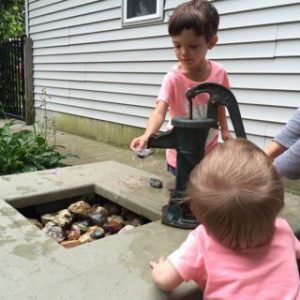
I love water play almost as much as I love blocks. When you have water in your play area, it is the equalizer among all children. Regardless of their age or language or social ability, water will bring them together. We love water play so much that we created our pump with the help of a buried rain barrel. Water gives us plenty of opportunities to understand volume and measurement and estimation. It turns dirt into mud, which makes it easier to find worms! It is a loose part. It may be my absolute favorite loose part. Be sure to add it in some form to your play area because it is so incredible.
This is one of our favorite stories, about water and time and discovery. We had our pump and I had some fabric in the yard as a loose part for making forts or whatever. These boys decided they wanted to capture water in the fabric.
I knew it wasn’t going to work, but why would I say no to such a learning opportunity. So,
 the boys started pumping the water into the bright blue fabric.
the boys started pumping the water into the bright blue fabric.
HUH????? No way! Oh my goodness! Who knew that fabric was actually waterproof? 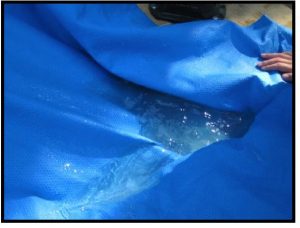 Ha! So now we had ourselves a project! The boys quickly decided this could create an amazing mote in the sandbox.
Ha! So now we had ourselves a project! The boys quickly decided this could create an amazing mote in the sandbox.
WOW!
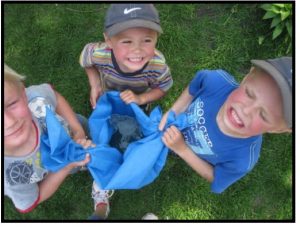
Another lesson learned in giving children long periods of time, never stopping the obvious and the importance of loose parts. Look at the delight on their faces! Okay, well maybe one is carrying most of the load, but the other two are thrilled.
Let them play!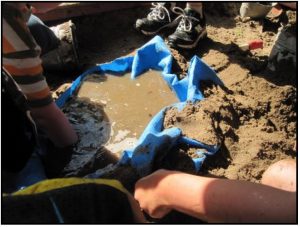
So, let’s talk some more about water and containers. Many cities are giving away rain barrels or offering them for sale. These make fabulous sources of water, specifically if you have a spigot for your child to control. Think of the math opportunities of measuring, estimating, mixing. If you don’t have a water resource nearby, take some out with you. Think about milk jugs or buckets or big thermoses with spigots. Children love spigots. It gives them power to control something. You will also love having a source of water to wash your child before they return indoors.
Oh, how we love to cook. We do a lot of cooking around here, often outdoors, with loose parts and water. We spend hours mixing and stirring and adding and serving. Cooking is a math-athon of opportunities. (Yep, I think I made that word up. I like it!) It is important when you are cooking for play or cooking for actual consumption that children have their own bowls and utensils. It adds to the learning value. Watching your friend is not the same as having your own bowl, measuring spoons and spatula. We have been through many types of pots and pans and spoons and measuring devices. I recently jumped on a deal for a plastic children’s toy tea set to add to our play. I normally stay away from such things, but I’ll admit it, the price and the reviews sold me. Sadly, I didn’t love it. Within six months it was stained, and ugly and just not nice to look at. It didn’t seem to bother the children, but it bothered me. For the same amount of money, I could have purchased A LOT of real pots, pans, spoons, measuring cups and utensils from a garage sale or Goodwill. Keep it real. Include pots and pans, pouring pots for sure, and utensils and most importantly sand and water. We have tried to get away from plastic shovels but they really are nice for what we use them for. Metal shovels are sharper and heavier and just don’t seem to work as well for us. Metal works well for dirt. In sand, we use plastic.
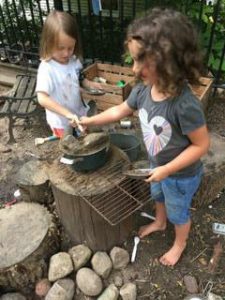
Sand. I know, I know. A lot of parents hate it. I promise you it will bring you hours and hours of deep, calm, investigative, creative play. The bigger the area, the bigger the creations and the more friends can play. Mud kitchens are all the rage right now and for many of the same reasons. I, personally prefer sand. It’s easier for me to clean up with a household of little friends. Sand, dirt, and mud are essential parts of loose parts play. Think of it as a short-term investment for long-term brain development. Sand and dirt support children on the mathematical learning journey. Children will explore space and measurement and shapes. They will start making comparisons of dry and wet and how that affects what they are building or mixing.
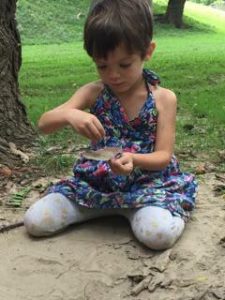
This is where loose parts will come in handy. They are the ingredients and the spices. You will want lots of rocks, flower petals, grass clippings, native prairie grasses, sand, small sticks, and feathers. The more choices the better, because every experience changes the recipe! There’s a whole lot of math going on.
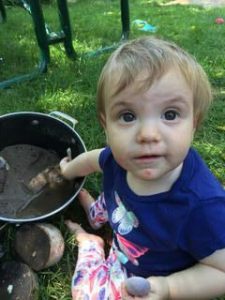
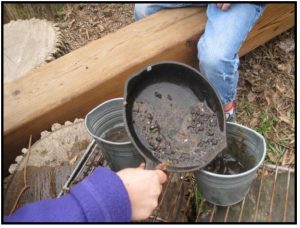
If I still haven’t sold you on sand or water play, let’s try rice. We color our rice with liquid watercolor, but plain rice is just fine. I have really gotten away from using our sand and water table very often. They aren’t nearly as easy to use as tubs on the ground. We like to use these big tubs. You could use those long, plastic storage containers for under the bed or oil drip pans from the auto supply store for a fraction of the price I paid for these, and the colors will be much less annoying. The long, plastic storage containers also come with the bonus lid, which is great for storage. We like to lay out a large sheet or blanket to help with clean up. Be sure to add funnels and all the utensils listed above. The measuring and pouring and learning will bring you hours of quiet time. The rice is very calming and it is so very inviting.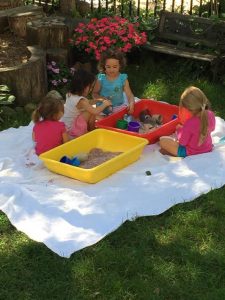
I watched these four-year-olds as they investigated the rice one day. I knew it was coming.

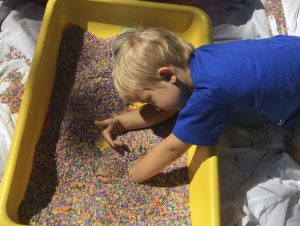
………yep, yep, there it is.
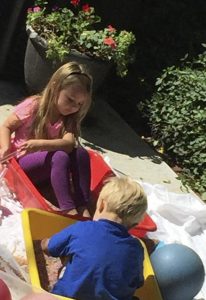
Good stuff that rice is. Just like a day at the beach. Cheap, because that’s math, and we like cheap. Buy the big 25-pound bag because like sand, more is better. Your child may need to crawl into it someday!
How absolutely wonderful using a worm to measure! I love the idea of using what is in your own backyard however unlikely as a tool for measuring!
This is great, isn’t it? I would have never thought of using a worm as a measurement tool either. How fun, and sticky!
Great example of both direct and indirect usage of measurement in this activity.
The children in my class love measuring! I used simple lengths of yarn at first. Then later in the year I used ruler and they loved using them! We were measuring so many things!
Measuring worms would be a great activity. the children in my class are always diging up worm and bringing them to me..
i never would have thought to use a worm to measure! these ideas sound so fun and exciting.
FUN!
I love the idea of giving and encouraging children to carry tape measures with them on a walk! Such spontaneous measuring fun to be had.. It’s never occurred to me to do that, but we will, now!
Man there is so much learning happening here . As a preschool assistant teacher I love how many things they can learn about and get their hands on with with exploitative lesson out in nature, such as measuring, how their world works, problem solving, and working together.
There were so many sensational learning experiences! I liked the aspect of measuring with worms and providing books about worms to lessen the anxiety if some of the children exhibited fear. I also loved the aspect that the children felt free to experiment and capture the water in the material to later create a mote. Wonderful imaginative play!
I never thought of this idea. I’m absolutely do this with the kids.